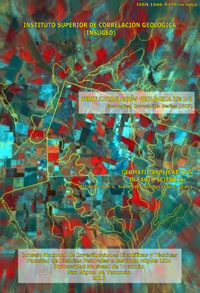Serie Correlación Geológica 33
Análisis espectral y petrográfico del Complejo Volcánico Sierra de San Miguelito, S.L.P. México
Marco Antonio Rojas Beltrán | Cristina Noyola Medrano | Rafael Gaytan Martínez
Descargar trabajo en formato PDFResumen
Este trabajo presenta el análisis espectral y petrográfico de las unidades litológicas del Complejo Volcánico de la Sierra de San Miguelito (CVSSM), ubicado en la región central del Estado de San Luis Potosí, México. El CVSSM consta de diez unidades volcánicas de roca félsica del Oligoceno con variaciones en el grado de silicificación, argilización y oxidación. Las unidades fueron agrupadas en 5 clases de litología: riolita, riodacita, latita, traquita y basalto. El registro de firmas espectrales se hizo con
un espectrorradiómetro hiperespectral Apogee UV-NIR PS-300. Las firmas espectrales se obtuvieron de cada afloramiento visitado en campo y en laboratorio a partir de muestras de mano. El protocolo del muestreo espectral incluye tres registros en cada punto de campo y en el laboratorio. El dato reportado en este trabajo, es la firma promedio tanto de la roca sana como de la roca alterada y/o intemperizada. Adicionalmente, se realizó el análisis petrográfico de 5 muestras representativas de cada clase de litología para establecer la mineralogía y las relaciones texturales de las rocas del CVSSM. Los resultados muestran que las firmas espectrales de las riolitas, riodacitas y traquitas son muy similares. Los tres tipos de roca muestran un patrón ascendente hasta los 600 nm y un pico de reflectividad hacia los 750 nm. Además, en la riolita se observa una meseta estable hasta los 900 nm. En las firmas de campo y laboratorio de la riolita se observan valores altos de reflectividad pero, hacia los 500 nm, las curvas espectrales de la roca intemperizada y fresca se cruzan, invirtiendo sus porcentajes de reflectividad. El basalto presenta los valores de reflectividad más bajos de toda la secuencia volcánica. Los registros de firmas espectrales de la alteración permiten constatar que la argilización muestra valores de reflectividad que varían de 40 % hasta > 100 %. La oxidación muestra dos picos de reflectividad, uno a los 600 nm y otro a los 700 nm, generando un patrón distintivo entre la roca sana y la alteración. La silicificación comúnmente viene asociada a la oxidación, por esa razón no se logró separar su respuesta espectral.
Abstract
SPECTRAL AND PETROGRAPHIC ANALYSIS OF THE VOLCANIC COMPLEX SIERRA DE SAN MIGUELITO, S.L.P. MEXICO. This paper presents the analysis of spectroradiometric and petrographic data from lithological units of the Sierra de San Miguelito Volcanic Complex (SSMVC), located in the central region of the State of San Luis Potosí, Mexico. The CVSSM consists of ten felsic volcanic units of the Oligocene with variations in the degree of alteration of silicification, argilization, and oxidation. The lithological units were grouped into five classes: rhyolite, rhyodacita, latite, trachyte and basalt. The spectral signatures were recorded using a hyperspectral spectroradiometer Apogee model UV-NIR PS-300. The obtaining of spectral signatures was for each outcrop in the field and on hand samples of rock in the laboratory. The protocol of the spectral sampling includes three records in each point of the field, as well as, three records of each sample in the laboratory. The data reported is the spectral signature average (field and laboratory) from the fresh and the altered rock. Also, for five representative samples of each kind of lithology, a petrographic analysis was performed to establish the mineralogy and the textural relationships of the SSMVC rocks. The results show that the spectral signatures of the rhyolites, trachytes, and riodacites are very similar. The three kinds of rock have an ascending pattern until 600 nm, and a reflectivity peak is evident at the 750 nm. In addition, in the rhyolite unit is observed a stable plateau at 900 nm. In the field and laboratory signatures, the latite shows high values of reflectivity, but at 500 nm the
spectral curves of the altered and fresh rock are intercepted by changing upside down their percentages
of reflectivity. The basalt presents the values of reflectivity lowest in the entire sequence volcanic. The records of spectral signatures of the altered rock reveal that the argilización displays values of reflectivity that varies from 40 % to > 100 %. The oxidation shows two peaks of reflectivity, one at 600 nm and another at 700 nm, generating a distinctive pattern between the fresh and the altered rock. The silicification is commonly associated with oxidation, for that reason, it was not possible to separate its spectral response.






